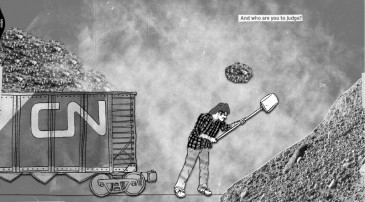
In the National Film Board-produced interactive web documentary Welcome to Pine Point, Paul Shoebridge and Michael Simons, who make up the Vancouver graphic design team the Goggles, offer an ironic welcome to the region. The irony being that the small mining town in the Northwest Territories is no longer there. The town’s disappearance, or rather, erasure from the Canadian landscape back in 1988 is the focus of the project.
The interactive web doc is an exploration of memory and form, offering a unique way of looking back at photographs of former Pine Pointers since we now know what they didn’t back then—that it would all, one day, come to an end. “Would it be so bad,” the pair ask, if “your hometown never changed?” In a way, the question implies that memories preserve Pine Point exactly as it was. As I navigated the site at my dining room table, I couldn’t help but wonder if memories could really preserve a place like Pine Point.
There’s solace in the idea that not being able to return means that the town can, at least in its former residents’ minds, live forever, altered only by slight variations in memories as they’re recalled. The doc recalls many of these memories from the point of view of three past residents of Pine Point. They each share old yearbook photos, video footage and memorabilia, which have been pieced together on the site by Shoebridge and Simons. Looking at the faces of ordinary, friendly people set against the industrial landscape of Pine Point evokes a kind of sadness, but the images still give the impression that everyone was glad to be there. Pine Pointers admit that the government’s decision to close the town after the mine’s closure is sad because they can’t go back; nevertheless, they seem to look back fondly, admitting with pride that Pine Point will always be their hometown.
Welcome to Pine Point’s bittersweet walk down memory lane is accompanied by the equally ominous and oddly triumphant sounds of the Besnard Lakes. The documentary features several familiar sounds from their second album, The Besnard Lakes are the Dark Horse, along with an original score composed by the band. They also offer up a cover of Trooper’s “We’re Here for a Good Time (Not a Long Time)”—fitting not only for its obvious connotations but also because, contradictory to what the song’s title suggests, Pine Point is still seemingly living on through the memories of the people who once called it home.
The project, which grew out of the observation that nobody uses traditional photo albums anymore, might have just as easily explored the memory of Pine Point in print. But something about the marriage of new media and old reflects how much has changed in how we archive our memories. The online experience simulates turning the pages of an old photo album, but it goes one step further by adding voices and music to score the experience. Further still, we’re shown old video footage from before the town’s closure as we silently read the accompanying text. When we’re ready, we turn the page.
The doc could be summed up as a nostalgia, but it’s so much more. The interactive content, accompanied by the sobering sounds of the Besnard Lakes, serves as a lament for a time when “community” wasn’t a buzz word exploited by social media, it was a way of life. It asks us to reconsider our sense of place and explores the validity of a collective memory, exposing both the humour and sadness that coexist within it.

